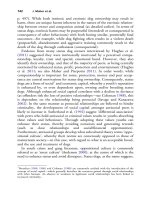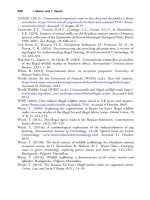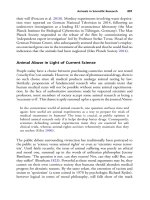The palgrave international handbook of a 126
Bạn đang xem bản rút gọn của tài liệu. Xem và tải ngay bản đầy đủ của tài liệu tại đây (38.12 KB, 1 trang )
116
A. Arluke et al.
association of Toxoplasmosis with animal hoarding is questionable. The definitive
hosts of T. gondii, and the only animals capable of spreading the parasite to
humans or other warm-blooded animals are felines. However, many hoarding
cases involve non-feline or non-mammalian species (for example dogs, birds,
reptiles). It has been difficult to demonstrate T. gondii in the brain of patients with
mental disorders, particularly schizophrenia, perhaps because the effect of the
parasite, if real, is likely to be early in life at the neurodevelopmental stage rather
than at the age of actual illness onset (Fekadu et al. 2010). To date, there have
been no specific studies of T. gondii seroprevalence levels in animal hoarders.
Societal Factors
In many parts of America, abandoned and stray animals remain a big
problem in part due to irresponsible breeding of pets that produces millions
of unwanted animals (Benniston 2015). Euthanasia practiced by openadmission shelters became a way to manage this overpopulation problem,
since not all of these unwanted animals could be adopted or kept indefinitely
in their cages. However, there has been growing pressure to adopt a ‘no-kill’
philosophy which has contributed to the growing number of ‘rescue hoarder’
cases that are investigated (Benniston 2015).
People in the community, knowing the hoarder’s reputation for wanting
any animals, may drop off unwanted pets at the hoarder’s home, thereby
feeding their ever-growing collection. In this way, the neighborhood ‘cat
lady’ or ‘dog lady serve as a convenient, impromptu shelter where there will
be no guilt imparted by staff members for dropping off unwanted animals
(Frommer and Arluke 1999) and no risk of euthanasia.
The many factors that can be associated with animal hoarding are not mutually
exclusive. Genetic predisposition and/or neurological impairment may interact
with disrupted childhood attachments, abuse, trauma or other triggers which,
coupled with societal reinforcement and reliance on interactions with animals to
create a positive self-image, creates conditions conducive to animal hoarding.
Responses to Animal Hoarding
Discovery, Investigation and Documentation
The complex nature of hoarding cases makes them difficult to investigate and
to resolve. Jurisdiction for these cases in the USA cross many state and local
agencies and departments, including mental health, police, humane law









